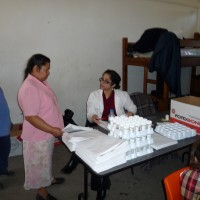
MEXICAN CERVICAL CANCER SCREENING STUDY II
This project took place in the State of Michoacán Mexico. Enrollment was conduced from December 2008 through March of 2009. Approximately 2500 women took part in the study.
The primary objective of this study is to design a cost-effective, highly sensitive and highly specific screening program able to be adapted to all socioeconomic levels in the State of Michoacán, Mexico.
Secondary Objectives are the following; 1) To Determine the comparative sensitivity and specificity of primary HPV screening (using self-sampling and direct sampling) using the Gen-Probe APTIMA HPV Assay for the detection of high-grade pre-cancer and cancer of the cervix, 2) To study the role of VIA to allow safe and effective treatment triage in screen positive women in Michoacán, Mexico, and 3) To determine if the new design for the HPV self-sampler device is a simple and comfortable tool for HPV detection.
After obtaining informed consent, women who met inclusion/exclusion criteria collected a self sample for HPV using the POI/NIH device and placed in PreservCyt to be processed using Hybrid Capture II and Gen-Probe APTIMA assays. Next, a physician collected a direct sample for HPV and Cytology. The physician collection device alternated between the Rover’s brush placed in PreservCyt and the Gen-Probe brush placed directly in Gen-Probe media.
Specimens were transferred to the POI laboratory in Morelia, Mexico. The cytology and the HC-II was processed in Mexico. The samples collected for Gen-Probe were shipped to Gen-Probe laboratories in San Diego for processing.
All participants were recalled on specific days as the study progressed to receive their HPV and cytology results. The patients that were HPV positive on any test and/or cytology greater than or equal to ASCUS (read at the Cleveland Clinic) were further evaluate by VIA, colposcopy and biopsy. VIA was used to identify lesions inappropriate for intermediate cryotherapy (high grade lesions defined as greater than or equal to 3 quadrants or suspicious of cancer). Colposcopy and biopsy were done using the POI biopsy protocol (link). Cryotherapy was done on any HPV positive women unless their lesions were identified as inappropriate for immediate cryotherapy, in which case women were referred for appropriate care. Women whose biopsies proved undertreated, were recalled for further treatment. (Biopsies read by Cleveland Clinic Gynecologic Pathology) Follow up was conducted at 6 months and has recently been completed at 2-2 1/2 years.
2 papers have been published (Int J Gynecol Cancer 2010 Nov;20(8):1415-23; Int J Gynecol Cancer. 2013 Mar; 23(3): 513-8.) reporting the acceptability of a POI self-collection device and the use of a mRNA primary screening assay respectively. A third paper has recently been accepted examining the 6 month and 2+ years follow-up after cryotherapy (Starks et.al. J Lower Genital Tract Disease) .
